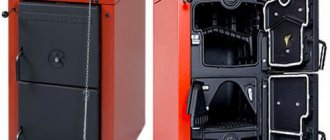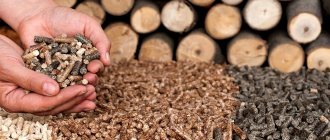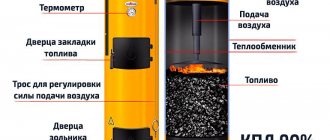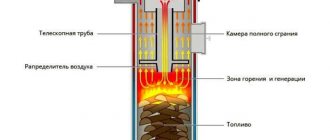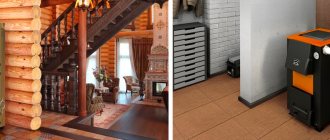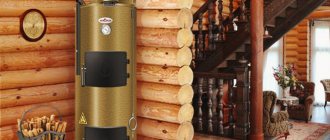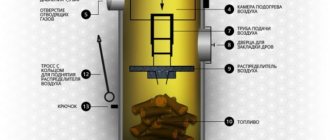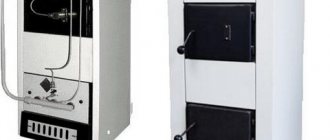What are coal boilers?
Coal is a solid fuel consisting of combustible substances, the main part of which is carbon. Coal is widespread in all Russian regions, much more than main gas, fuel oil and heating oil.
Coal-fired boilers have various modifications and designs
Continuously rising energy prices are increasing the role of long-burning coal-fired boilers as an alternative to gas units. Coal also has superiority over wood, since when 1 kg of coal is burned, they release 2 times more thermal energy.
A long-burning coal boiler is a variation of a solid fuel unit, the mechanism of which is most optimized for the use of coal as an energy carrier.
The use of modern technologies allows such inertial units to operate automatically. The control unit autonomously monitors combustion processes, thereby ensuring its maximum efficiency.
Why is coal the best fuel for home boilers?
When choosing fuel for heating a private home, it is important to know how well it will burn. This is the main indicator. Each type of fuel has its own characteristics.
Below you can see the efficiency indicators of different types of fuel.
We have included the most important parameters in the table.
Among them:
- Heat of combustion - how much heat the material will release
- Ash content - non-combustible residue
- Humidity - the lower it is, the higher the heat of combustion
- Bulk density - how many kilograms will one cubic meter weigh?
- Price – this point needs no comment
We will talk about all these parameters regarding coal a little later. In the meantime, you can compare its performance with that of other types of fuel.
Table of indicators of different types of fuel
| Heat of combustion | Ash content | Humidity | Bulk density | Price* | |
| Coal | 5795-7459 kcal/kg | 2,1-3,2% | 3,2-12,4% | 800 kg/m3 | from 4400 RUR/t (with delivery) |
| Brown coal | 3100-3600 kcal/kg | 15-27% | 14-22% | 900kg/m3 | from 4200 RUR/t (with delivery) |
| Anthracite coal | 6700 kcal/kg | 5-20% | 5-7% | 850 kg/m3 | from 8000 RUR/t (with delivery) |
| Firewood | 2500-3400 kcal/kg | 2,4-3,2% | 20-25% | 480 kg/m3 | from 2100 RUR/t (with delivery) |
| Eurodrova | 4500 kcal/kg | 1% | 8-12% | 1200 kg/m3 | from 7500 RUR/t (without delivery) |
| Peat briquettes | 4200 kcal/kg | before 18% | up to 25% | 250 kg/m3 | from 9000 RUR/t (without delivery) |
| Pellets | 4300-5200 kcal/kg | 0,4-1,5% | 8-12% | 650-750 kg/m3 | from 5300 RUR/t (without delivery) |
*Prices are valid for Ekaterinburg
If we compare all the parameters, then only anthracite is more profitable than coal. But its closest deposit, in relation to Yekaterinburg, is located in the Rostov region. Considering delivery to the Sverdlovsk region, the cost of such fuel will be unreasonably high. Chopped firewood and brown coal are cheaper than coal. But their heat of combustion, as can be seen from the table, is much lower. We must not forget that wood burns faster, so you need to purchase it more often. Thus, in our region it is more profitable and efficient to heat houses with coal.
In addition to the characteristics, you need to understand whether coal is suitable for your boiler. This will be discussed below.
Application and effectiveness
Coal boilers for heating a private home have found application in regions of Russia where there is no main gas supply, and there is also a shortage of other energy resources: firewood, electricity.
The popularity of coal is higher near major transport hubs, since large quantities of coal are mainly transported by rail.
In order to increase the efficiency of a coal boiler, it is necessary to perform a number of measures. They start by choosing a brand of coal. It is mined in mines and may contain 15-20% waste rock, which cannot burn and produces a lot of ash.
Unprocessed coal has an ash content of up to 30%. Therefore, for energy purposes, coal undergoes special processing at enrichment complexes, which increases the efficiency of units, for traditional coal devices up to 70-75%, and for automatic ones - almost up to 90%.
In addition, in order to increase the economical operation of the heating system of a house equipped with a coal-fired unit, it is necessary to take into account the following points:
- Do not use raw coal, since a significant part of the energy from the thermal cycle will be used to dry it.
- Monitor the condition of the chimney system and heating surfaces of the boiler; they must be clean.
- Provide sufficient air. In the room where the unit is installed, there must be effective triple supply and exhaust ventilation.
- Use thermostats in the operating circuit of an automatic coal boiler.
- Effectively insulate your home.
- Improve the in-house thermal circuit, install a circulation pump and an indirect hot water heating boiler.
By what criteria to choose
Many owners of private houses buy a boiler based on efficiency. Long-term combustion coal units have an efficiency of 82-87%, in contrast to pyrolysis units, but the latter devices are more expensive.
Important selection criteria:
Equipment power. The calculation is made from the proportion of 1 kW of thermal energy to heat 10 sq.m of area. Moreover, it is recommended to add 10-15% for heat loss, incl. take into account the climatic features of the region.- Degree of automation. Boilers that independently ignite and maintain combustion are considered more convenient, but they are more expensive.
- Loading chamber volume. It must match the power of the device. It is believed that 1 kW accounts for 3.3-5.1 liters of volume. You can do the calculation yourself: the manufacturer indicates the necessary information in the instructions.
- Ability to work with different types of fuel. There are models on which a gas or pellet burner is additionally installed.
- Energy independence. There are devices on the market with thermomechanical control that do not require current. And automatic units require connection to the electrical network.
- Ease of control and additional options. There are models that provide not only safety elements (emergency switches or various valves), but also convenience functions (self-cleaning system, the ability to remotely control using a phone, etc.).
The materials from which the boilers are made play an important role. In high-quality models, the body is made of thick and heat-resistant boiler steel and cast iron. The latter is more durable, lasting an average of 25 years. In addition, it stores heat well and is not subject to corrosion.
Damaged steel cases (they are made from an alloy with a wall thickness of 4 mm or more) are easier to repair. If cracks appear on cast iron, then a complete replacement of the product is necessary, since cast iron is less resistant to temperature fluctuations and pressure changes.
Design and principle of operation of coal-fired boilers
Traditional solid fuel coal boilers are manufactured with different configurations, but one thing remains unchanged - the organization of the combustion process. Coal boilers for heating a private home are produced with a heat exchanger made of steel or cast iron, with top or front loading of fuel.
There are boilers with natural draft and those operating with air pressurization by an axial fan. The last option provides power control. According to the principle of coolant movement through the heat exchanger, they differ, like boilers operating with natural and forced circulation.
Before putting coal into the boiler, it is heated with wood. When the hot ash from burnt firewood fills the grate, coal is poured in, which burns in the combustion chamber and forms flue gases.
They wash the combustion heating surfaces in the form of a heat exchanger and thereby heat the coolant entering the heating radiators. After this, the coolant cools down and returns to the boiler, thus the heating cycle will be completed and the next one will begin.
Advantages and disadvantages of equipment
Using a boiler for heating with coal in a private house is accompanied by several positive aspects:
- ease of maintenance;
- high efficiency;
- uninterrupted operation throughout the full season;
- possibility of combination with wood raw materials;
- process automation;
- provided smoldering operating mode;
- efficiency.
Weaknesses of the equipment:
- the boiler room must be ventilated - this is a mandatory condition for fire safety;
- the need to arrange a technically complex chimney;
- you need to equip a dry place for storing coal.
The heating system usually operates together with a smoke exhauster and a fan; these are quite energy-intensive mechanisms.
Varieties
Automatic coal boilers are grouped into 4 basic types: traditional, pyrolysis, pellet and long-burning. Certain models combine different design options, for example, in a traditional boiler unit I install a pellet burner.
Long-burning coal boilers
Boilers operating on the principle of long combustion are otherwise called “top combustion”. They are distinguished by a long period of work on the first coal load.
In such designs there is no ash pan or grate; moreover, the bottom of the device is completely solid, and therefore combustion of fuel in the lower part is categorically unacceptable. The combustion chamber has a cylindrical shape. Air is supplied from above, strictly in the center.
Fuel combustion process
In order to organize such an air supply scheme, an air distributor is installed in the firebox, which has the ability to move down along with the fuel during the combustion process.
The air continuously approaches exactly the upper combustible layer, where hydrocarbons are partially oxidized, that is, the process of pyrolysis occurs. Products containing ash particles fly up into the combustion space. They are separated from the primary combustion zone by a thick metal disk mounted on a dynamic air-blowing tube.
In this secondary combustion chamber, atmospheric air enters the pyrolysis gas, volatile combustible substances burn, releasing heat, which is supplied to the heat exchanger, which heats the coolant for the heating system.
Pyrolysis coal boilers
Another very popular option for a coal unit is a pyrolysis or gas generator. The pyrolysis process has long been used in many industrial applications in the pharmaceutical and petroleum industries.
In coal-fired boilers, pyrolysis involves the slow thermal decomposition of coal under oxygen deficiency. In this case, pyrolysis flammable gases are released from the fuel, which penetrate through special passages in the loading chamber into the secondary chamber, into which the calculated volume of air is supplied by a fan.
Volatile gas substances ignite and burn completely, ensuring efficient operation of the device with the highest efficiency for coal boilers - 92%.
Bunker automatic boilers
Modern autonomous coal boilers, operating in automatic mode, are controlled using a controller and a screw fuel supply mechanism. The boiler system is equipped with forced air supply and smoke removal.
To keep heating surfaces and smoke channels clean, a stationary self-cleaning device is installed. Coal boiler houses equipped with such units do not require a large number of maintenance personnel due to the high level of automation of the combustion process.
Boiler with coal bunker
Operating principle of automatic coal boilers:
- When the unit starts, the screw fuel supply starts.
- The first share of coal is ignited by electroplasma.
- As combustion proceeds, a fresh portion of fuel enters the combustion chamber. The increase in unit productivity is regulated by the speed of the screw conveyor.
- Simultaneously with the screw fuel supply, a dosed air supply into the combustion chamber is turned on.
- The controller determines the rate of air intake, thereby regulating the intensity of the combustion process.
- Automatic grates dump ash residues into the ash box.
- Soot cleaning is carried out by special springs installed inside the channels.
Features of heating with coal
Coal boilers have a number of advantages over other types of heat generators used for home heating. First of all, it is relatively low cost and simplicity of design. Compared to pellet options, coal models are 15-30% cheaper, but slightly more expensive than wood boilers.
Another advantage of a coal boiler lies in the duration of fuel combustion. Coal burns much longer than wood, so some models can operate on one load of the firebox for up to 24 hours or more, which is on average 3 times longer. The efficiency, by the way, is also higher, 75-90%, depending on the design features of the boiler.
Important! Coal heat generators can also use briquettes and firewood as fuel, although in this case there is a decrease in their efficiency by an average of 20%.
As for coal, the following grades are mainly used for solid fuel boilers:
- Long-flame gas (LNG).
- Anthracite.
- Brown coal.
The latter brand of coal is unstable, and its shelf life is a maximum of 6 months. This fuel is also sorted by fraction diameter, where small grades are well suited for automatic equipment.
To determine which coal is best to use, you should rely on the recommendations of the heat generator manufacturer, as well as the characteristics of a particular type of fuel.
The main characteristics of coal that you need to pay attention to include:
- Heat of combustion (calorie content) . The highest temperatures are produced by anthracite (8600 Kcal/kg) and coking coal (8700 Kcal/kg). The latter is not recommended for use in domestic boilers, as it is dangerous.
- Ash content is the percentage of ash in coal that will not burn. The higher it is, the worse the fuel; the boiler will have to be cleaned more often. Anthracite is the leader in this indicator.
- Internal moisture - unlike surface moisture, which is removed by drying, it is removed only by combustion. In addition, with an increase in internal humidity, the fuel gives less energy to heating the house, spending part of it on the evaporation of this very moisture.
Among the main features of coal boilers used to organize autonomous domestic heating at home, the following stand out:
- A wide range of capacities, which allows you to heat areas of 50 – 1000 sq.m.
- Even the best coal boiler requires periodic maintenance: adding fuel and cleaning.
- Release of dust and soot into the room when loading the combustion chamber. This is one of the reasons for the need for a separate boiler room, the area of which will be at least 6 sq.m.
- Dependence of the amount of waste on the ash content of the fuel.
- The need to allocate space for fuel storage.
To ensure complete combustion of coal in the combustion chamber, it is recommended to lay out layers of firewood, unless this is contraindicated for a particular brand of boiler, which is usually not the case. This simple move allows you to increase the overall performance of the unit.
How to choose
When choosing a specific model of coal boiler for a residential building, several factors should be taken into account: thermal power and size of the heated area, type of combustion, type of heat exchanger - cast iron or steel, energy independence, safety, efficiency, weight of the unit and its price.
Direct long burning or pyrolysis
In order to compare boiler units by type of combustion: long burning or pyrolysis, compare the main operating parameters of coal boilers:
- Efficiency: Long-term combustion - from 75 to 85%, pyrolysis - from 85 to 92%.
- Possibility of autonomous operation: long burning - yes, pyrolysis - yes.
- Energy independence: long burning - yes, pyrolysis - yes.
- Permissible fuel humidity: long burning - from 30%, pyrolysis - up to 15%.
- Acceptable fraction: long burning - up to 50 mm, pyrolysis - from 25 mm.
Thus, today it is possible to draw the main conclusion - it is simply not possible to burn fuel more efficiently than in an automatic pyrolysis solid fuel boiler using coal and wood.
Heat exchanger material
The type of material from which the body of a coal boiler is made is the main factor that determines the durability and maintainability of the heating system:
- Steel is a relatively light metal that can withstand changes in pressure and temperature. Its disadvantages include susceptibility to corrosion processes and burnout in the zone of maximum temperatures.
- Cast iron is the most durable material and is used in all powerful units. However, it does not withstand shock and temperature changes well. In addition, if fistulas form in the walls, it will not be possible to weld them, as in steel products.
Modern boilers, using the positive qualities of both metals, are produced in a steel body and with a cast iron combustion chamber.
Single-circuit or double-circuit
Single-circuit or double-circuit are available, either only for heating, as in the first option, or, respectively, for heating and hot water supply - in the second.
In this case, double-circuit boilers operate on the principle of switching hot flue gases to the DHW circuit when the valve on the mixer is opened. Coal units have a fairly pronounced low inertia, so it is practically possible to regulate the heating medium between the circuits only in pyrolysis devices.
Therefore, for many options for coal boilers, the preferred hot water supply scheme remains, organized through an additionally installed indirect heating boiler. In this case, the efficiency of the heat supply system is significantly increased by reducing the temperature of the exhaust gas.
Minimum required power and heated area
In order to determine the approximate thermal power, use a practical formula depending on the heated area of the room:
Mk = Pd x 0.1 where:
- Mk - design power of the boiler, kW;
- Pd - area of the house, m2.
- 0.1 - specific power indicator per 1 m2 of area (W/m2).
This calculation does not take into account many more important parameters of the house, for example, such as the level of thermal insulation, glazing area, roof structure and climatic region of residence.
These calculations are complex and can only be performed by special design organizations or using software packages.
Therefore, in everyday life, an approximate calculation is carried out, which is carried out according to the principle “from small to large” - the power is set for each room separately, and then the result is summed up. This approach also allows you to determine the number of metering devices required for each room.
Another difference for coal boilers in this calculation method, which will need to be taken into account when selecting equipment. The power according to the formula takes into account the calorific value of standard coal, which in reality is much worse, so an adjustment of 20% is made to accurately determine the coal consumption in a solid fuel boiler.
Efficiency
Efficiency - represents the ratio of the volume of fuel consumed to the volume of thermal energy generated by a coal boiler. This is the most important indicator of equipment efficiency and fuel use.
It depends on the thermal design and the use of innovative technologies in the boiler design. In EU countries, due to strict environmental protection requirements, the installation of new devices with an efficiency below 90% is not allowed. High-tech condensing domestic boilers today operate with an efficiency of 100-105%.
What coal is better to use and how to calculate the consumption?
The efficiency of using products depends on the calorific value of the variety; usually, the technical documentation for the equipment indicates the optimal names. Below are 5 rational variations in order of increasing productivity:
- brown coal,
- bituminous,
- stone,
- semi-anthracite,
- anthracite.
Anthracite, the most efficient type of fuel, produces about 34 thousand kJ/kg when burned; with the same initial values, it produces 80% more heat than diesel fuel or natural gas. “Medium” hard coal, for comparison, produces 27 thousand kJ/kg.
The material is sorted by piece size:
- the smallest – “seed” – reaches a diameter of 10-24 mm;
- middle fraction – “walnut” – within 25-50 mm;
- the large version - “fist” - has parameters of 50-100 mm.
Varietal raw materials packaged in bags are sold at a slightly higher price than those sold in bulk. There is a difference: in the first case, the coal does not contain dust; it interferes with normal combustion. Also, if you purchase fuel in bags, it will be easier to control its weight when loading it into the chamber.
When determining the flow rate, the following parameters must be taken into account:
- calorific value of fuel;
- boiler efficiency;
- unit power;
- average duration of its use (daily).
For heating 1 sq.
meters of housing, the boiler must produce at least 1.2 kW per day, for this you will need to burn 0.15 kg of anthracite, 0.19 kg of stone or 0.32 kg of brown coal. The amount of fuel of the selected type must then be multiplied by the area of the house - the daily consumption is formed. We bring the resulting figure into line with the duration of the heating season - on average, it is 181 days.
The best known manufacturers and models with prices
The Russian market for climate control equipment is saturated with coal-fired boilers, both domestic and Western-made. Moreover, Russian modifications have the best price-quality ratio.
Boiler Protherm Beaver 20 DLO
However, at present, the most functional ones with automatic operation are coal units from European companies.
For example, the following models became popular models of coal boilers with a 200 m2 area, according to buyers, in 2022:
- ZOTA “Master” 20, price as of 01/01/2020 - 31,889 rubles.
- Protherm “Beaver” 20 DLO, price as of 01/01/2020. — 38,440 rub.
- Bosch “Solid” 2000 B SFU 12, price as of 01/01/2020 - 51,430 rubles.
- Stropuva S15U, price as of 01/01/2020 - 39,789 rubles.
- Buderus “Logano” S181-15 E, price as of 01/01/2020 - 258,800 rubles.
- Teplodar "Kupper" OK 20, cost as of 01/01/2020 - 28,340 rubles.
- Thermocraft "Uragan" Prof 22, cost as of 01/01/2020 - 34,650 rubles.
Automatic fuel supply methods
Based on the methods of fuel supply, units with a pneumatic conveyor and a screw transmission are distinguished.
The choice of design depends on:
- noise level during operation of the heating installation;
- power consumption;
- frequency of fuel delivery to the combustion chamber and other indicators.
Pneumatic conveyor
Combustible materials are delivered to the main chamber of the boiler using air, which is pumped under pressure. The advantage of such models is that fuel is supplied less frequently. As a result, the system will be able to operate without electricity for a longer time. However, the pneumatic conveyor makes more noise during operation and consumes a lot of electricity - about 1.5–2 kW/hour.
Screw transmission
This method is used in most household units and is considered the most reliable, but it is not ideal.
Feeding is carried out via a screw conveyor, which operates almost silently and consumes less electricity - about 80 W/hour. The feed speed is adjusted automatically.
The use of an auger guarantees the flow of fuel into the boiler, but if its length is more than 2 m, flammable materials are ground into dust.
Installation procedure
The boiler is a high-risk facility; it must be installed according to the design of a specialized organization that has licenses for the relevant types of work.
Algorithm for carrying out work when installing a coal boiler:
- Preparatory measures are being carried out: Selecting a room for the furnace and concreting the base for placing the unit and auxiliary equipment.
- The boiler is connected to the in-house heating circuit.
- The boiler is connected to a smoke ventilation system.
- Install auxiliary equipment: blower fan, centrifugal pump, air vents, safety valve, temperature sensors, water purification filter and expansion tank.
- Perform a test run and pressure testing of the system with water pressure of 1.5 working hours to check the tightness of the connection of pipe and structural elements.
What to look for when choosing coal
There are many subtleties that relate to specific boiler models. For example, it is not recommended to constantly use long-flame brands “large nut” and “small nut” in ZEUS-TURBO boilers. This can lead to small fractions blocking the access of air through the grate, and large fractions to hang in the loading chamber.
The range of boilers is too large to describe the design features of each of them. Therefore, we will not touch on this issue, but will tell you what is important to consider when choosing coal. However, we strongly recommend that you carefully study the instructions specifically for your boiler before purchasing fuel.
Let us highlight the main indicators that need to be taken into account when choosing coal:
- Heat of combustion
- Ash content
- Humidity
Operation: how to properly heat a boiler with coal
Ignition of coal boilers is carried out with a small amount of wood chips and paper, after which the firebox door is closed. Open the blower so that the draft ensures the combustion process. If the unit has an air supply regulator, it is set to a temperature of 70 C.
After burning wood for 20 minutes, the boiler firebox and gas ducts warm up enough that coal can be thrown in. The gate valve opens completely. During the lining process, the blower is closed. Only after this do they open the combustion door and lay a layer of coal up to 6 cm, and after it has burned out, the next layer of coal will need 20 cm.
Summarizing the above, we can draw the following conclusion that solid fuel boilers operating on coal fuel are still in demand, both in the field of individual heating of residential buildings and in production, where industrial coal boilers are still functioning in sufficient quantities.
Modern advances in the field of boiler construction make it possible to use cast iron heating surfaces in the most advanced innovative boilers.
Is coal right for you?
To answer this question, let's look at two important points:
- Boiler type
- Coal fraction
Let's take a closer look at each of them.
Boiler type
Solid fuel boilers can operate on any solid combustible material. Therefore, formally we can say this: coal will suit you in any case. The only question is whether it will be effective.
It is important to understand that each boiler is designed for a specific fuel. For example, wood-burning boilers burn wood; pellet - on compressed granules. And so on. In the passport, each manufacturer indicates the preferred type of fuel. If firewood is indicated there, this does not mean that coal cannot be thrown. But the effect will be much lower.
If your boiler specifies coal as the main fuel, then you can expect high efficiency when using it.
If you plan to heat your house with coal, then you need to purchase a coal boiler.
Coal fraction
This is another important indicator, and it is also related to the possibility of using coal in the boiler.
The fact is that the fuel supply in household boilers is carried out through a rather small hatch. It is not always possible to place material with large pieces in it. After mining, coal is sieved and divided into fractions by size. Some of the material is supplied in the form in which it was mined. This is the 0-300 fraction, or the so-called raw coal. It contains both large pieces (up to 300 mm) and dust.
We have the following varieties on sale:
- 20-40 mm – small long-stone nut (HOUSE)
- 50-200 mm – long-flame slab (WPC)
- 0-300 mm – regular long-flame (DR)
For all home boilers from this list, only one fraction is suitable - 20-40 mm. It contains small grains that are easily loaded into the firebox and burn evenly.
Fractions 50-200 and 0-300 are cheaper, but are not suitable for home heating. They can contain both small and large grains. Such coal will burn unevenly, and unburned pieces will remain. If you have an automatic boiler, then large grains will simply clog the feeder, and as a result, coal will stop flowing into the firebox altogether.
Let's summarize:
For household coal boilers, you should purchase coal of a fraction of 20-40 mm.
User manual
First, paper is placed in the firebox, then firewood and coal.
Instructions for kindling and operating a coal unit are included with each unit. Regardless of the manufacturer’s brand, there are general rules for using a direct combustion boiler:
- Light the boiler by throwing some coal into the firebox.
- Place paper and small wood chips on top of the rock.
- Light the paper. From it the fire will go to the firewood, then to the top layer of coal material.
- After a crust has formed, crush the top layer with a poker. This will facilitate the penetration of air to the lower layer.
Further work involves adding coal, breaking up sintered pieces and removing slag.
Coal-fired boilers are an economical solution for private homes and cottages. Thanks to the long combustion of the fuel, a comfortable temperature is maintained for several hours. Before purchasing, you need to pay attention to the type of device and its characteristics.
Connecting to the heating system
When the installation of the solid fuel unit and the installation of the chimney are completed, proceed to piping the boiler. The main rule applies here: cold water should not get into a working heat generator (especially with a cast iron heat exchanger). Then, condensation forms on the walls of the firebox due to the temperature difference, which turns into a viscous crust after mixing with soot.
For reference. Sticky deposits are difficult to clean off, and in addition, it significantly reduces the efficiency of a solid fuel installation.
The release of condensate during operation of a solid fuel boiler is minimized using a standard piping scheme with a bypass and a three-way valve set to a fixed coolant temperature of 50 or 55 °C. The water circulates in a small circle until it heats up to the specified temperature, then the valve begins mixing in cold water from the heating system.
All the details of connecting a solid fuel boiler are described in a separate publication. There are also diagrams for connecting the heater with a buffer tank and parallel heat sources - gas and electric.
Advice. When piping the pellet boiler, pay attention to the connection of the control unit and burner. In products of European manufacturers, there is an automatic fire extinguishing system powered from the water supply network. To avoid making mistakes, before installing a TT pellet boiler, you should consult with a technical specialist of this brand.
Your task is to install shut-off valves, an expansion tank for a closed heating system and a circulation pump in accordance with the diagrams, fill the pipeline network and create a pressure of about 1 Bar in it. Next is trial lighting and performance testing. The full range of work on installing a wood-burning boiler is reflected in the next video:
Specifics of installation work
Boiler power depending on the area of the house.
Installation of solid fuel boilers is carried out without permission from supervisory services. Users will need to follow several rules:
- It is better not to install the unit in a living room - dust, soot and soot will be released. Installation in the hallway, bathroom, kitchen, or bathroom is allowed.
- For models with a power of 60-150 kW, based on SNiP 42-01-2002, a boiler room with a volume of 15 m3 and a ceiling height of 2.5 m is required.
- Smoke removal and ventilation systems are mandatory.
- Boiler units with a power of up to 50 kW are placed on a screed; those above 50 kW are placed on an individual concrete foundation with a protrusion of 25 cm from the body.
- Ventilation is done in the form of a supply opening opposite the boiler. A grated hood is also required.
- The chimney is made of a pipe with a cross-section of 150-200 mm2. It should not have bends or slopes.
- The obligation is performed using a bypass or three-way valve set to a water temperature of 50-55 degrees.
- The optimal pressure parameter in the circuit is 1 bar.
The return and gravity main feed are supplied directly to the boiler.
